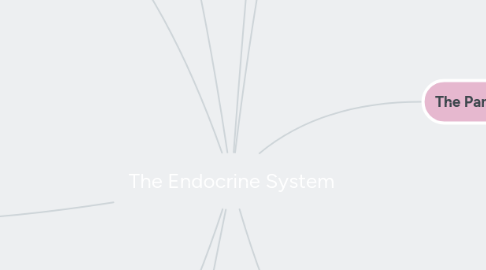
1. The Thyroid Gland
1.1. Inferior to the Larynx
1.2. Made up of follicle glands
1.3. Follicle glands producs:
1.3.1. T3 and T4 hormones
1.3.1.1. C Cells lie inbetween follicles which produce calcitonin. This help regulate calcium homeostasis.
2. The Parathyroid Gland
2.1. Embedded in the posterior surface of the lateral lobes of the thyroid gland.
2.2. Produced two main epithelial cells:
2.2.1. Chief (principal) cells: produce parathyroid hormones (PTH)
2.2.2. Oxyphil Cell (function not known)
2.3. Major regulator of ions in the blood:
2.3.1. Calcium
2.3.2. Magnesium
2.3.3. Phosphate
2.4. Increase the number and activity of Osteoclasts (bone breakers)
3. The Adrenal Glands
3.1. Located superior to the kidneys
3.2. Consists of adrenal cortex and inner adrenal medulla.
3.3. 3 major Parts:
3.3.1. Zona Glorumelosa
3.3.1.1. Products Mineralocorticoids: Aldosterone ( Regulates homeostasis of potasium and sodium and helps adjust blood pressure and blood volume.)
3.3.2. Zona Fasciculata
3.3.2.1. Products (Glucocorticoids): Cortisol, Corticoesteron and cortisone regulate metabolism and resistance to stress.
3.3.3. Zona Articularis
3.3.3.1. Products (Androgens) : In males very low secretion of androgens.
3.3.3.2. In females : Promote libido and are converted intro estrogens.
3.4. Adrenal Cortex
3.4.1. Cortisol
3.4.1.1. Stress hormone
3.4.2. Aldersterone
3.4.2.1. Regulation of Blood pressure
3.5. Adrenal Medulla
3.5.1. Adrenaline
3.5.1.1. Fight ofr flight response
3.5.2. Noradrenaline
4. The Ovaries and Testis
4.1. Ovaries
4.1.1. Produced estrogen and progesteron that regulate the meuntral cycle, maintains pregnancy and prepares the mammary gland for lactation.
4.2. Testis
4.2.1. Production of testosteron which regulates prodcution of sperm and stimulates the development of male secondary sex characteristics (beardm hair growth, voice change)
5. Thymus
5.1. Located behind the stermin between the lungs.
5.2. Produces:
5.2.1. Thyrosine
5.2.2. THF ( Thymic Humoral Factors)
5.2.3. TF (Thymic Factors)
5.2.4. Thymopoetin
5.3. Promote the mutation of T cells (type of cell that destroys microbes and foreing substances) and may retard ageing process.
6. The Hypothalamus
6.1. It is a structure of the diencephalon of the brain located interior and inferior to the thalamus.
6.2. Has both neural and endocrine functions, producing and secreting hormones.
6.3. Functionally related to the pituitary gland.
6.4. Regulates: Hunger Body Temperature Thirst Sleep
7. The Pituitary Gland
7.1. Posterior Pituitary
7.1.1. Oxytocin Hormone
7.1.1.1. Stimulated the contraction of the muscles in the uterus (Positive Feedback)
7.1.1.2. Important in milk ejection reflex when breastfeeding.
7.1.1.3. Also important in the feeling of love, closeness and sexual attraction.
7.1.2. Antidiuretic Hormone
7.1.2.1. Reclaims water from the Kidneys and conserves them in the bloodstream. (Negative Feedback)
7.2. Anterior Pituitary
7.2.1. Growth Hormone
7.2.1.1. Accelerates the rate of protein synthesis in skeletal muscle and bone
7.2.1.1.1. Too much of the growth hormone : Giantism
7.2.1.1.2. Too little of the growth hormone : Dwarfism
7.2.2. Thyroid Stimulation Hormone
7.2.2.1. Regulated by Thyrotropin or TSH (Thyroid stimulating hormone)
7.2.2.2. Triggers the secretion of Thyroid Hormones by the Thyroid Gland.
7.2.2.3. Releases T3 (Triiodothyronine) and T4 (Thyroxine)
7.2.3. Adrenocorticotropic Hormone
7.2.3.1. Stimulates the adrenal cortex to secret corticoid steroid hormones such as cortisol.
7.2.3.2. Primary Stress Hormone: Increases sugar (glucose) levels in the bloodstream.
7.2.3.3. Fight or flight response
7.2.4. Follicle Stimulating Hormone and Luteinizing Hormone
7.2.4.1. Secrete hormones that help with the control and regulation of the reproductive system. Ovaries in women and sperm in men.
7.2.4.2. Women: Production of estrogen and progesterone by the ovaries.
7.2.4.2.1. Men: Production of testosterone by the men testis.
7.2.5. Prolactin
7.2.5.1. Promotes lactation (milk production) in women
8. The Pancreas
8.1. Located in the curve of the duodenum, the first part of the small intestine, and consist of head, body and tail.
8.2. two main types of cells:
8.2.1. Alpha Cells
8.2.1.1. Secrete Glucagon
8.2.1.1.1. Glucagon raises blood glucose by glycolgenolisis
8.2.2. Beta Cells
8.2.2.1. Secretes Insulin
8.2.2.1.1. Lowers glucose levels
